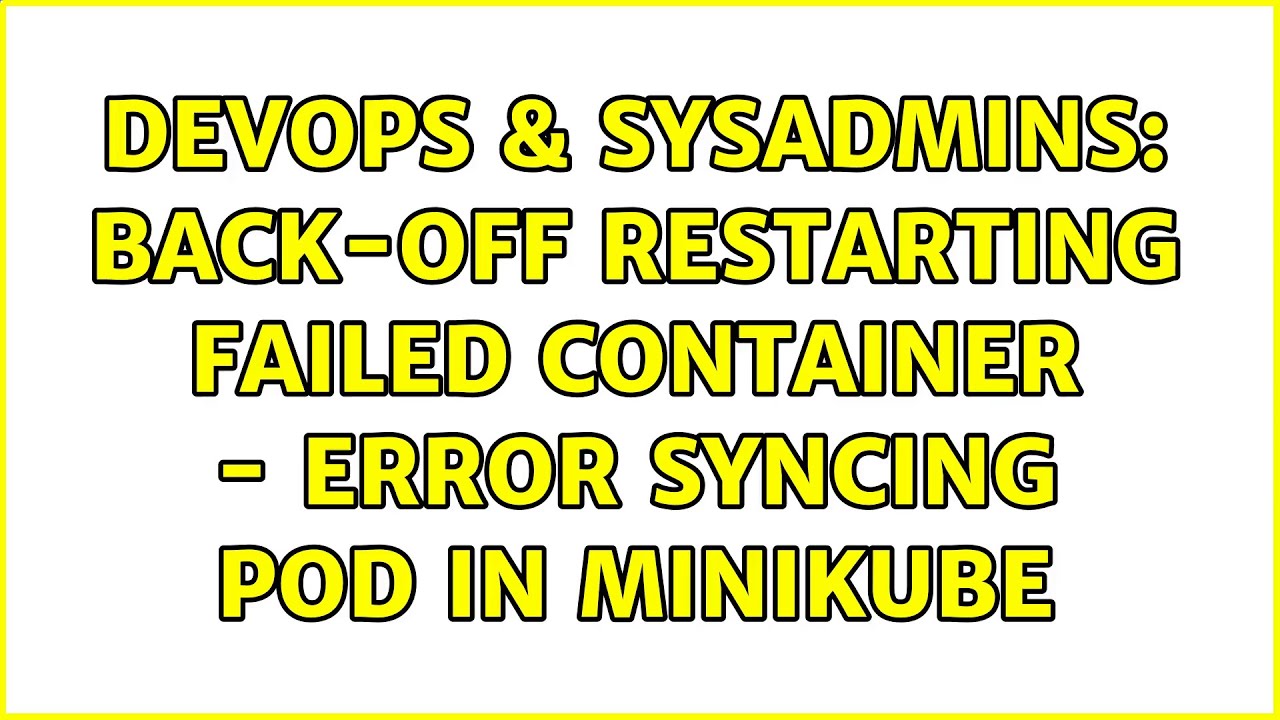Back-Off Restarting Failed Container

In the dynamic landscape of containerized applications, the resilience of our systems often hinges on how gracefully we handle failure. Containers, with their ephemeral nature, are no strangers to occasional mishaps. When a container fails, whether due to resource constraints, environmental issues, or software bugs, a robust strategy for handling these failures becomes paramount. One such strategy gaining traction is the concept of “back-off restarting.” In this article, we delve into the nuances of back-off restarting failed containers, exploring its significance, implementation, and best practices.
Understanding Back-off Restarting
At its core, back-off restarting is a strategy employed by container orchestrators to manage the restart behavior of failed containers. Instead of blindly attempting to restart a failed container immediately, a back-off strategy introduces a delay between successive restart attempts. This delay typically increases with each consecutive failure, hence the term “back-off.”
The rationale behind back-off restarting is twofold: first, it prevents a thundering herd problem where multiple instances of a failing container compete for resources simultaneously, potentially exacerbating the issue. Second, it allows the system to recover gracefully by giving it time to stabilize or resolve underlying issues that may have led to the failure.
Implementing Back-off Restarting
Container orchestrators like Kubernetes have built-in support for back-off restarting through configurable parameters. Kubernetes, for instance, allows operators to specify the maximum number of restart attempts (spec.restartPolicy) and the back-off parameters (spec.containers.livenessProbe.initialDelaySeconds, spec.containers.livenessProbe.periodSeconds, etc.).
The back-off strategy typically follows an exponential pattern, where the delay between restart attempts grows exponentially with each consecutive failure. This exponential back-off mechanism is adjustable, allowing operators to fine-tune the behavior according to the specific requirements of their applications.
Best Practices for Back-off Restarting
1. Understand Application Requirements:
Before implementing a back-off restarting strategy, it’s crucial to understand the resilience requirements of your application. Some applications may tolerate more aggressive restart policies, while others may require longer intervals between restart attempts to prevent cascading failures.
2. Monitor and Analyze:
Effective monitoring is essential for gauging the health of containerized applications. By tracking metrics such as restart frequency, error rates, and resource utilization, operators can identify patterns of failure and fine-tune the back-off parameters accordingly.
3. Graceful Degradation:
Consider implementing graceful degradation mechanisms within your application to handle transient failures gracefully. This could involve implementing retry logic, circuit breakers, or fallback mechanisms to mitigate the impact of failures without resorting to excessive restart attempts.
4. Leverage Probes:
Utilize Kubernetes liveness and readiness probes to detect and respond to application failures proactively. Liveness probes can trigger container restarts when the application becomes unresponsive, while readiness probes prevent traffic from being routed to unhealthy instances.
5. Test, Test, Test:
Regular testing is essential for validating the effectiveness of your back-off restarting strategy. Simulate failure scenarios in a controlled environment to verify that the system behaves as expected under various conditions.
Case Study: Netflix Chaos Monkey
Netflix, renowned for its robust microservices architecture, employs a tool called Chaos Monkey to test the resilience of its systems. Chaos Monkey randomly terminates instances and containers in production to ensure that the system can withstand failures gracefully. By incorporating chaos engineering practices like Chaos Monkey, Netflix validates the effectiveness of its back-off restarting strategies and reinforces its commitment to reliability.
Conclusion
In the relentless pursuit of resilience and reliability, the concept of back-off restarting offers a pragmatic approach to handling failures in containerized environments. By introducing a deliberate delay between restart attempts, back-off restarting mitigates the risk of exacerbating issues and allows systems to recover gracefully. However, implementing an effective back-off strategy requires careful consideration of application requirements, proactive monitoring, and continuous refinement based on real-world observations. With the right approach and mindset, back-off restarting can be a powerful tool in the arsenal of container orchestration, ensuring that our applications remain resilient in the face of adversity.





